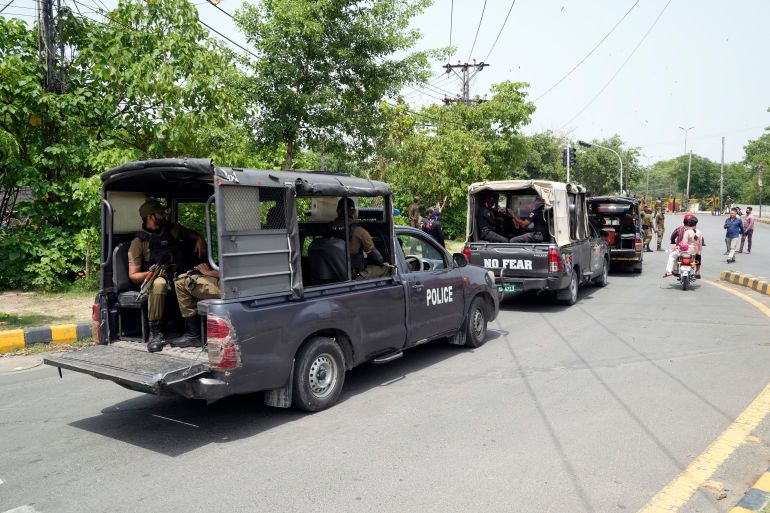This short description is from a detailed book " A pilgrimage to Nejd" by Lady Anne Blunt , 1881

Meshhed Ali (the shrine of Ali), or Nejef as it is more correctly called, is an ideal Eastern City, standing as it does in an absolute desert and bare of all surroundings but its tombs. It is nearly square, and the circuit of its walls is broken by only one gate. These walls are of kiln-burnt brick, and date from the time of the Caliphs, and are still in excellent preservation. They are strengthened at intervals by round towers, all very massive and stately. So high are they, that they completely hide every building inside them, with the single exception of the great Mosque of Ali, whose glittering dome of gold shows like a rising sun above them.
Inside, the houses are closely packed; but there is more symmetry in their arrangement than in most Asiatic towns, as the bazaar leads in a straight line from the gate to the Mosque, which stands in the centre of the town. The shops are good, or appeared so to our eyes unused to the things of cities.
I did p. 102not myself venture far inside, as the streets were very crowded, and we did not wish to attract unnecessary notice just then at the time of the pilgrimage; but Wilfrid describes the faade of the Mosque as the richest he has seen, a mass of gold and mosaic work like some highly chased reliquary. He would not go inside for fear of offending our pilgrim friends, and left it to the rest of our party to recount the splendours of the tomb.
This tomb of Ali is held by the Shias as at least as holy as the Caaba at Mecca, and it is an article of pious belief with them that any Moslem buried within sight of the dome is certain of salvation. The consequence is that pilgrims from all parts of the Shia world, and especially from Persia, come to Nejef to die, and that immense numbers of corpses are sent there for interment. Burial fees in fact constitute the chief revenue of the place.
This city and Kerbela, where there is the sister shrine of Huseyn, are inhabited by a number of Mahometan subjects of Her Majesty, from India, who have settled in them from religious motives, but remain under the protection of the British Resident at Bagdad. They live on good terms with the Arabs, but do not mix much or intermarry with them, and retain their own language. As is natural in cities of pilgrimage, all classes are ostentatiously religious, and we were amused at listening to the devout exclamations of the blacksmith who came to shoe our horses. Ya Ali, ya Huseyn, ya Ali, ya Mohammed, at every stroke of the hammer.
They are all, moreover, bitterly hostile to Turkish rule, having the double motive of national and religious antipathy to support them. Both Meshhed Ali and Kerbela are kept strongly garrisoned, but in spite of everything have constantly revolted within the last forty years. When we were at Meshhed, the Turkish Caimakam had four companies of infantry under his orders; and the garrison of Kerbela, the head quarters of the district, was far larger.
Kerbela, which lies fifty miles north of Meshhed Ali, is physically quite unlike its rival. It is unfortified, and instead of standing in the desert, is surrounded by palm gardens, like the towns of Nejd. It is a richer and more populous city than Meshhed, but to a traveller it is less interesting as having nothing distinctive in its appearance. The Hiudieh canal, which supplies it with water from the Euphrates, makes it the centre of the most considerable agricultural district of the Bagdad pashalik. Meshhed, on the other hand, has little besides its shrine to depend on.

source

Meshhed Ali (the shrine of Ali), or Nejef as it is more correctly called, is an ideal Eastern City, standing as it does in an absolute desert and bare of all surroundings but its tombs. It is nearly square, and the circuit of its walls is broken by only one gate. These walls are of kiln-burnt brick, and date from the time of the Caliphs, and are still in excellent preservation. They are strengthened at intervals by round towers, all very massive and stately. So high are they, that they completely hide every building inside them, with the single exception of the great Mosque of Ali, whose glittering dome of gold shows like a rising sun above them.
Inside, the houses are closely packed; but there is more symmetry in their arrangement than in most Asiatic towns, as the bazaar leads in a straight line from the gate to the Mosque, which stands in the centre of the town. The shops are good, or appeared so to our eyes unused to the things of cities.
I did p. 102not myself venture far inside, as the streets were very crowded, and we did not wish to attract unnecessary notice just then at the time of the pilgrimage; but Wilfrid describes the faade of the Mosque as the richest he has seen, a mass of gold and mosaic work like some highly chased reliquary. He would not go inside for fear of offending our pilgrim friends, and left it to the rest of our party to recount the splendours of the tomb.
This tomb of Ali is held by the Shias as at least as holy as the Caaba at Mecca, and it is an article of pious belief with them that any Moslem buried within sight of the dome is certain of salvation. The consequence is that pilgrims from all parts of the Shia world, and especially from Persia, come to Nejef to die, and that immense numbers of corpses are sent there for interment. Burial fees in fact constitute the chief revenue of the place.
This city and Kerbela, where there is the sister shrine of Huseyn, are inhabited by a number of Mahometan subjects of Her Majesty, from India, who have settled in them from religious motives, but remain under the protection of the British Resident at Bagdad. They live on good terms with the Arabs, but do not mix much or intermarry with them, and retain their own language. As is natural in cities of pilgrimage, all classes are ostentatiously religious, and we were amused at listening to the devout exclamations of the blacksmith who came to shoe our horses. Ya Ali, ya Huseyn, ya Ali, ya Mohammed, at every stroke of the hammer.
They are all, moreover, bitterly hostile to Turkish rule, having the double motive of national and religious antipathy to support them. Both Meshhed Ali and Kerbela are kept strongly garrisoned, but in spite of everything have constantly revolted within the last forty years. When we were at Meshhed, the Turkish Caimakam had four companies of infantry under his orders; and the garrison of Kerbela, the head quarters of the district, was far larger.
Kerbela, which lies fifty miles north of Meshhed Ali, is physically quite unlike its rival. It is unfortified, and instead of standing in the desert, is surrounded by palm gardens, like the towns of Nejd. It is a richer and more populous city than Meshhed, but to a traveller it is less interesting as having nothing distinctive in its appearance. The Hiudieh canal, which supplies it with water from the Euphrates, makes it the centre of the most considerable agricultural district of the Bagdad pashalik. Meshhed, on the other hand, has little besides its shrine to depend on.

source
- Featured Thumbs
- http://www.gutenberg.org/files/42215/42215-h/images/fp.jpg
Last edited by a moderator:





























